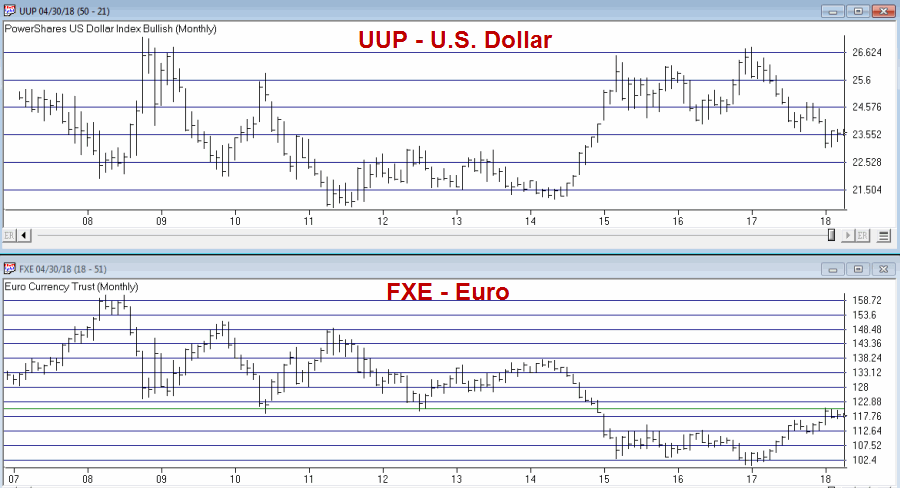If you have read any of my pieces lately you are already aware that as it relates to the financial markets a lot of things are presently at a critical juncture (including my sanity, but I digress). Today let’s add the U.S. Dollar to that seemingly ever longer list of financial areas that appear to be at a crossroads. And this one has some large implications simply because a lot of other markets are affected at least to some extent by what happens in the dollar.
Figure 1 displays the Spot U.S. Dollar on a monthly basis.
 Figure 1 – U.S. Dollar Monthly (Courtesy ProfitSource by HUBB)
Figure 1 – U.S. Dollar Monthly (Courtesy ProfitSource by HUBB)
The reality is that there is no one definitive price at which to draw a “definitive” line in the sand. So I arbitrarily picked two. There is nothing “magical” about these two lines and a move above or below either does not technically “prove” anything. Still, as far as this range goes, a lot of previous price moves have “gone here to die” so to speak.
Now this is the point in the article where a skilled analyst would explain in painstaking detail why the dollar is absolutely, positively destined to move higher (or lower) from here. Sorry, folks I honestly don’t know. But there are two things I do know which might still prove useful:
1) For every prognosticator out there pounding the table that the dollar is sure to move higher there is another (equally slightly crazed) prognosticator averring that the dollar is destined to decline. And the key thing to note is that they both can make a pretty compelling case.
2) A lot rides on which way the dollar goes from here, because there is no shortage of markets that react – at least in part – to the movements of the U.S. dollar. This means that alot of trading opportunities will be affected/created by the next big move from the dollar.
A few examples appear in Figure 2 below which displays the inverse nature of the correlation between the U.S. Dollar (using ticker UUP as a proxy) and the market in question (for the record, a figure of 1000 means the market moves exactly like the dollar and a figure of -1000 means the market moves exactly inversely to the dollar).
Figure 2 – Correlations to U.S. Dollar (Courtesy AIQ TradingExpert)
Now the fact that foreign currencies (ticker FXE – which tracks the Euro) move inversely to the U.S. Dollar is fairly obvious. But note that on this list are:
*Foreign Bonds and U.S. Bonds (BWX and TLT)
*Precious Metals (GLD and SLV)
*Commodities (like coffee, soybeans and crude oil)
*Broad Commodity Indexes (DBC and GSG)
This encompasses a pretty darn wide swath of the trading world. And every single one of them will be influenced to some extent by which way the dollar goes from here.
As you can see in Figures 3 through 6 (click to enlarge any of the charts), what happens to the U.S. Dollar can matter a lot to what happens in these markets. Figure 3 – Dollar vs. Euro (Courtesy AIQ TradingExpert)
Figure 3 – Dollar vs. Euro (Courtesy AIQ TradingExpert)
 Figure 4 – Dollar vs. Bonds (Courtesy AIQ TradingExpert)
Figure 4 – Dollar vs. Bonds (Courtesy AIQ TradingExpert)
 Figure 5 – Dollar vs. Metals (Courtesy AIQ TradingExpert)
Figure 5 – Dollar vs. Metals (Courtesy AIQ TradingExpert)
 Figure 6 – Dollar vs. Commodity Indexes (Courtesy AIQ TradingExpert)
Figure 6 – Dollar vs. Commodity Indexes (Courtesy AIQ TradingExpert)
Summary
So the bottom line is that I do not know which way the dollar goes from here. But I do know that whichever way it goes a lot of “things” will likely go “the other way.” And everything listed in Figure 2 represents a lot of trading opportunities.
This represents a good time to invoke:
Jay’s Trading Maxim #17: (with credit given to George and Tom at Optionetics back in the day): Investing success involves two “simple” steps. #1) Spot opportunity. #2) Exploit opportunity. Everything you do as a trader or investor falls into one of these two categories.
A bunch of opportunities may soon be spotted (assuming the dollar actually ever does get around to deciding which way it wants to go…).
So focus here, people, focus…
Jay Kaeppel
Disclaimer: The data presented herein were obtained from various third-party sources. While I believe the data to be reliable, no representation is made as to, and no responsibility, warranty or liability is accepted for the accuracy or completeness of such information. The information, opinions and ideas expressed herein are for informational and educational purposes only and do not constitute and should not be construed as investment advice, an advertisement or offering of investment advisory services, or an offer to sell or a solicitation to buy any security.













